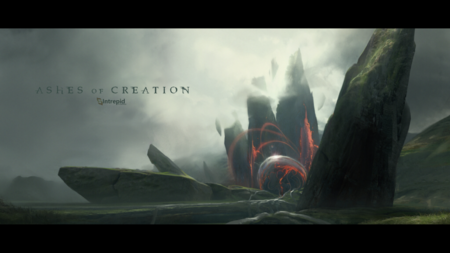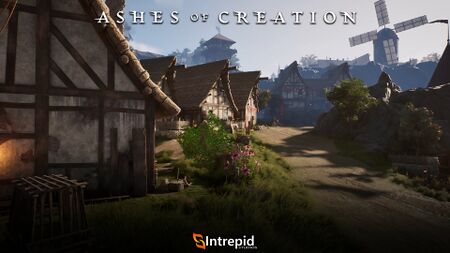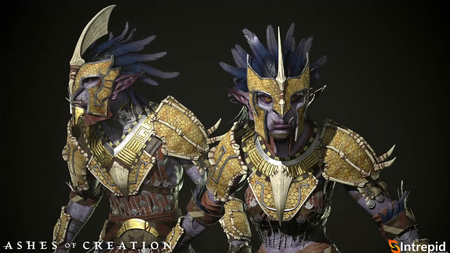Design pillars
The design of Ashes of Creation adheres to five main pillars.[1]
In designing Ashes of Creation, we adhere every detail to five main pillars: Engaging and Immersive Story, a Reactive World, Player Interaction, Player Agency, and Risk vs Reward. Even in the environment, everything you as the player do will tie into these pillars, while everything your guild does, everything your server does will ultimately keep the world fresh, ever-changing, and most importantly... exciting.[1]
Design
Ashes of Creation takes place within a medieval fantasy setting, blending imagination with cutting-edge graphics. We are putting the word massive back into massively multiplayer with unique and novel mechanics that will bring meaning to player action. Ashes of Creation will incorporate the best parts of traditional MMORPGs with innovative sandbox concepts. You will choose your fate at every opportunity. Questlines will open and close based on the interactions of the players with their world, because this is a world where choice is consequential. Monsters will roam and grow in ferocity as civilization disrupts the natural order of things. From the location of towns to the size of cities, you will determine the landscape of your world. It will be unique in culture, ecology, and economy.[3]
Ashes of Creation is an upcoming MMORPG set in a world of high fantasy where player’s choices will shape and define the world around them.[4]
- Ashes of Creation is a unique take on the MMO experience. Our world structure is dynamic and built to react to the actions of our players. Cities will rise and fall, their populations based on the history of the world as the players create it. Quests will unlock as these populations gather, their needs grow, and secrets are unlocked. As the world’s NPC structure is established in real time, players will have the ability to destroy what they’ve created, paving the way for new development, new populations, and real change. Political strife and intrigue will play a very real role in the structure of your world. Gone are the days of static worlds, change is here to stay.[3]
- The original code-name for Ashes of Creation was The World of Origins.[5]
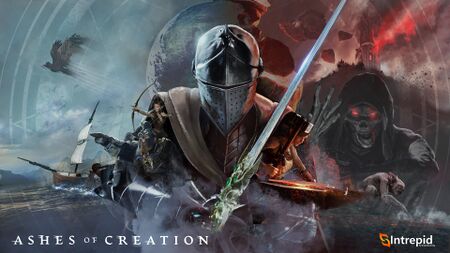
In order for sandbox mechanics to mean something, there must be curated content to accompany the player’s choices. Which means, as the developers, we must create that Themebox style content but for every possible path the community may take.[7] – Steven Sharif
Ashes of Creation is a PvX game built on the foundational principle of risk versus reward. The developers may seek feedback and make changes to portions of the game, but the core design pillars of the game will never be changed.[8][9][10][11][12]
- We will refine systems, we will iterate on systems, but we will never change the core identity of the intent and philosophical approach to what Ashes of Creation as an MMO brings to the MMO genre space... What we want to do is express that Ashes of Creation is endeavoring to build a risk-versus-reward centric PvX style game. And that intent and purpose will be delivered upon, and it will not change.[11] – Steven Sharif
- Ashes of Creation is referred to by the developers as a "themebox" or "sandpark" game as they aim to create a reactive player-driven world accompanied by curated content.[4][7]
- When it comes to how MMO’s have been traditionally designed, most gamers are familiar with two distinct types of gameplay loops: the “theme park”, and the “sandbox”. The vast majority of MMO’s we’ve all seen come and go in the gaming industry have been of the theme park variety – these games put the player onto a specific path, guiding them along, with plenty of pretty sights in between the same old quest hubs, very little in divergent paths, virtually no freedom in player progression. Recently the MMO genre has seen some games of the sandbox nature come onto the scene, but despite the ultimate freedom the sandbox affords players, many are left wanting more, as there is by definition no pre built world content, no human touch, just the vastness of the “sand” for lack of a better term. Thus many MMO players often find themselves caught between the repetitive rock of the theme park or the vast dead spaces of the sandbox’s hard place. This chasm between the state of MMO gameplay loops is where we intend to inject Ashes of Creation’s Node system.[4]
- Q: How do you go about designing some of the more old school systems such as XP debt, minimal fast travel, and open world raiding that have really gone away for the most part in modern MMOs?
- A: When looking at the reasoning behind why some of those old systems existed, a lot of it was centralized around the idea of risk versus reward. I mean, let's take a look at the three that you name, XP debt, minimal fast travel, and open world raiding. Experience debt is a cost of failure. Experience debt is the bite of not achieving success. If I die to a monster because my strategy was bad, because my performance was bad, because my planning was bad: all of that means that debt is the cost I pay for the bad choice... Minimal fast travel: My location matters; and the time it travels there is the cost I pay. Open world raiding: I'm not the only person interested in completing this objective. I have competition. That competition represents pressure. That pressure represents a desire to succeed and perform. All of those are touch points on player emotional connectivity. There is a reason why I want to succeed: Part of that reason can be incentivization through reward; part of that reason can be distance; it can be incentivization through failure. So that I think are one of the core fundamental philosophies as to how you design some of the more old-school systems.[13] – Steven Sharif
Inspiration
Ashes of Creation has taken inspiration from various other MMORPG titles.[14]
- In terms of what came before, we're trying to figure out who did what best and take inspiration from that: Move the genre forward; keep things updated and bring it into the 21st century.[14] – Jeffrey Bard
- Eve Online with its regionalized economy and risk vs reward in transportation.[14]
- ArcheAge with its building systems, transportation and naval combat.[14]
- Star Wars Galaxies with its crafting systems.[14]
- Lineage II with its risk vs reward, castle sieges, flagging, open world PvP and guild progression.[15][16][17][14]
- A lot of the systems in Lineage 2 were based around a concept that got lost today in mmorpgs, and that's risk versus reward. You know this idea that the more you risk the greater potential reward should be present is a complete paradigm shift away from everyone's a winner, everybody gets a participation reward, and here you go, congratulations you're a player in this game; and that's boring. It gives nothing for a person to aspire to achieve something, or to feel the bite of loss when you fail. Those are the driving forces of why people want to play games and it's a reason why new games when they come out have such a short lifespan, because they are always competing with WOW. You don't have to compete with WOW. You don't have to be a WOW killer. You can focus on something that is different from a philosophical design standpoint; and I think that's just what a lot of studios today don't want to take the risk on.[16] – Steven Sharif
End-game
Ashes of Creation will not have a typical end-game where content is essentially static and repetitive. Instead, max-level characters will be able to engage with many different gameplay loops that open up based on how the world progresses over time.[18][19]
- Endgame to me communicates static. It is static structure. Okay, you've entered this loop, now and this is your end-game loop that you will repeat over and over. Whereas instead, the approach for Ashes is you have now reached a point where all of these loops are relevant; and the loops are present to you depending on how the community engages the world. And it's up to you to identify the most promising loops because you have a finite amount of time and resources in which you can engage with them. And that's then where strategy becomes a part of the picture: How will I choose to engage with these loops to maximize my return, or to maximize the specific benefit I wish to bring in individual, group, myself, or guild.[18] – Steven Sharif
- Part of the whole experience with nodes is that there is no real end-game, in that the world is constantly shifting every day. Month one is going to be really different from month two; and that's for the level 50s and level 1s.[19] – Jeffrey Bard
Engaging and immersive story
Topics that reflect the past and the present of Verra.
- Classes | Archetypes | Roles
- Races | Religions
- Skills | Augments
- Lore | Story arcs
- Roleplaying | Social animations
- World map | Points of interest | Climate
- Environments | Underrealm | Undersea
Reactive world
Topics that describe how the world of Verra evolves based on player activity.
- Nodes | Node types | Node stages | Zone of influence
- Economy | Player businesses | Auction houses
- Artisan classes | Gathering | Processing | Crafting
- Quests | Events | Commissions
- Naval | Naval combat | Ships
- World bosses | Monster coins
- Destructible environments
Ashes of Creation will be a living, breathing, reactive world. Your actions will shape the Zones of Influence, leveling Nodes to form massive Cities, and create the story of the world that everyone experiences.[22] – Margaret Krohn
Player interaction
Game systems and mechanics that foster player interaction.
- Dungeons | Raids | Combat
- Guilds | Guild halls | Guild fortresses | Guild castles
- Group dynamics | Looting
- Affiliations
- Social organizations
- Parlor games
We decided to focus on mechanics that bring the idea of community to the forefront. To get people to interact with each other meaningfully – not just to conquer a raid boss, or to get some coin from a faceless auction house, but to maybe save a city. A city that all the local residents had a stake in. A city that the players had spent weeks or months developing; the defense of that city, the attack on that city! Or building a world together as a community choosing our own fate with our friends. We believe that’s going to be a story far more memorable and far more meaningful to players than just about anything we can come up with.[24]
Player agency
Systems that grow and shape player experiences in the game.
- Weapons | Armor
- Progression | Leveling
- Housing | Node housing | Apartments | Freeholds
- Mounts | Mules | Dragons
- Character creator | Gear appearance
- Cosmetics | Skins | Costumes | Accessories
- Inventory | Consumables
We will have a lot of content that is available, but those will be behind doors that are accessible through agency on behalf of the community. In a traditional sense, no we are not a theme-park, however we will probably have more content than a theme-park does, traditionally. Just because, in order for those choices to be meaningful, there must be meaningful content behind the door you choose.[26] – Steven Sharif
Risk vs. reward
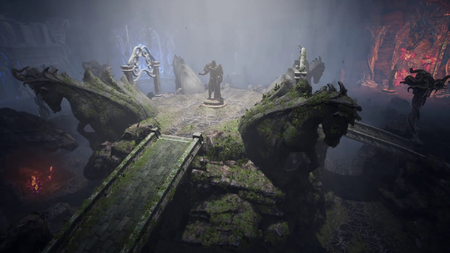
Risk is a healthy thing. Risk makes us value reward. Without risk we would not pursue certain achievements, because anybody could achieve them. Risk makes us have a sense of thrill, or have some sense of anxiety; and those are all emotional responses that get elicited when risk is present. So, risk isn't a bad thing. We like risk, not just in PvP but in PvE as well: when you can't always predict the environment or encounter you are part of, risk is something like 'Ah, I've never seen this boss do that before.' or these adds came at an ill-placed time, there's a trap here that I didn't experience before. There's a lot of elements that risk introduces that keep gameplay less stale; that keep it more dynamic; that introduce environments where the unexpected can occur. That is a good thing.[28] – Steven Sharif
Activities that reward daring adventurers and foster meaningful conflict.
- World PvP | Caravans | Guild wars
- Node sieges | Castle sieges
- Player corruption | Bounty hunters
- Arenas
- Achievements | Leader boards | Trophy park
- Exploration | Treasure hunting
- Stock exchange (sharemarket)
The risk versus reward relationship, when, say for instance, you've dedicated time towards building a node and other players have dedicated that equivalent time towards sieging the node, there's going to be a pitched battle between those players... They spend that time doing this because they care passionately about having access to that content.[29] – Steven Sharif
Historia strony
There were originally four design pillars: Economy, Nodes, Meaningful conflict and Narrative.[30]
- Q: Are there any mechanics or systems that you wanted to add to the game but haven't because you wanted to ensure that your development schedule stays on track? And if so, what are they?
- A: There's a lot. We- generally when we're doing our internal meetings and reviews and a great idea comes up, we throw it in the backlog post-launch. That's our- generally our MO when it comes to great ideas. Because the reality is, as we continue to go through features, we develop those features, we test those features and iterate on those features, a lot of new ideas and opportunities come about for the team to think about. Well, wouldn't it be great if this feature actually did this and interacted with another feature over here that did this. And so we're trying to make sure that another feature over here did this. And in some situations we'll evaluate and determine whether or not that type of interaction is really necessary to demonstrate what the core loop of a particular system might be trying to demonstrate and we'll make the changes necessary. But in the majority of cases, we try to stay cognizant of, hey, here is our MVP necessary list of core integrated systems in order to achieve the identity of the game that we're in the core gameplay loops that we want players to experience. And we work towards that end from a launch perspective; and anything that's added that sounds good, or we want to incorporate, we throw it into the expansion bucket. There's an opportunity for us to- we need stuff obviously for us to expand upon and for us to continue development post-launch, so that's generally our MO with regards to new ideas and stuff.[31] – Steven Sharif
See also
References
- ↑ 1.0 1.1

- ↑ Video, 2017-04-30 (0:00).
- ↑ 3.0 3.1 Ashes of Creation MMO.
- ↑ 4.0 4.1 4.2 A reactive world - Nodes.
- ↑ Podcast, 2021-04-11 (46:44).
- ↑ Transmisja na żywo, 2022-10-14 (37:10).
- ↑ 7.0 7.1 MMOGames interview, January 2017
- ↑ Transmisja na żywo, 2023-07-28 (1:30:11).
- ↑ Transmisja na żywo, 2023-04-07 (55:22).
- ↑ Transmisja na żywo, 2023-03-31 (1:00:16).
- ↑ 11.0 11.1 Transmisja na żywo, 2022-10-28 (32:52).
- ↑ Transmisja na żywo, 2017-06-01 (37:39).
- ↑ Transmisja na żywo, 2023-04-07 (40:30).
- ↑ 14.0 14.1 14.2 14.3 14.4 14.5 Wywiad, 2018-08-24 (8:35).
- ↑
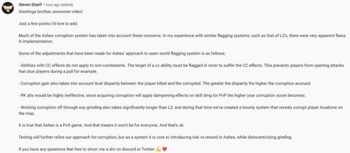
- ↑ 16.0 16.1 Wywiad, 2020-07-29 (9:02).
- ↑

- ↑ 18.0 18.1 Wywiad, 2023-07-09 (42:51).
- ↑ 19.0 19.1 Video, 2018-04-05 (40:08).
- ↑ Dillias diary.
- ↑ X.com - What do you all think about the aesthetic of this Village Node?
- ↑ Blog - Know Your Nodes - The Basics.
- ↑ Transmisja na żywo, 2022-01-28 (0:00).
- ↑ Ashes of Creation - A new Beginning.
- ↑ Transmisja na żywo, 2023-09-29 (1:02:44).
- ↑ Transmisja na żywo, 2018-04-8 (AM) (27:26).
- ↑ Video, 2017-07-16 (0:01).
- ↑ Transmisja na żywo, 2022-10-28 (13:53).
- ↑ Transmisja na żywo, 2017-05-22 (38:44).
- ↑ Transmisja na żywo, 2017-05-03 (11:33).
- ↑ Transmisja na żywo, 2023-04-07 (1:22:39).
